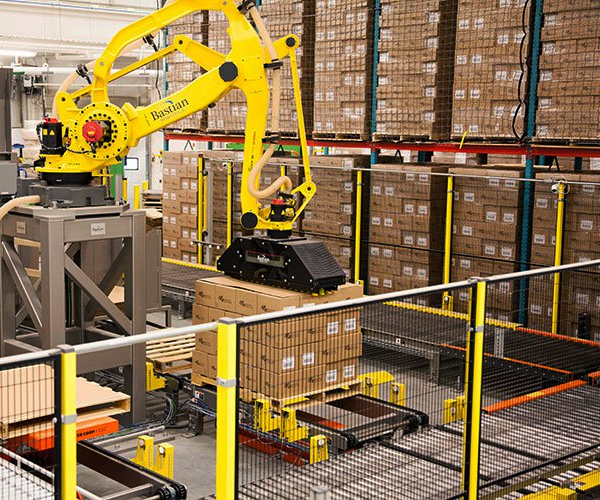Have you ever wondered how seemingly random products get stacked perfectly onto massive pallets ready for transport? It’s no easy task to carefully organize and combine myriad shapes and sizes into a stable structure built just for shipping. The process behind forming these palletized packages is called palletizing – a complex industrial operation that fuses artistry, engineering precision, and split-second timing.
Watching pallets take shape appears like magic to the untrained eye as each product finds its dedicated position. But beneath the surface lies an intricate dance between robotics, programming, and material handling to build these portable product platforms efficiently. In this article, we’ll remove the curtain on palletizing and explore how this ubiquitous packing process works its logistical magic.
Understanding the process
Palletizing is a critical process within the supply chain that is vital in enhancing the efficiency of transportation, storage, and distribution operations for various products. This method systematically involves carefully arranging individual items onto wooden or plastic pallets to create a consolidated unit load. Doing so ensures stability during handling with forklifts or pallet jacks, ultimately minimizing the likelihood of damage or loss while in transit.
The initial phase in palletizing encompasses determining the optimal layout for stacking products onto a pallet. This task involves a blend of engineering expertise and programming finesse. Professionals use advanced algorithms to calculate the most effective way to arrange products, considering crucial factors such as weight distribution and load stability. Once the ideal configuration is established, the next step involves handing the reins to robotic systems to execute the palletizing process seamlessly.
The role of robotics
Advancements in robotics have revolutionized the palletizing process, elevating its efficiency and precision to new heights. With robotic arms with sophisticated gripping tools, businesses can manipulate products of varying shapes and sizes with remarkable skill. These robots are programmed to follow the pre-established layout patterns, ensuring each item is placed accurately to maintain the stack’s integrity.
The robotic systems work tirelessly, often in environments not suitable for human workers, thereby enhancing safety and productivity on the factory floor. With continuous improvements in robotic technology, the future of palletizing looks to be increasingly automated, further streamlining the supply chain. Robot palletizing systems come in various shapes and sizes, handling an extensive range of products, from small delicate items to large bulky goods.
Material handling equipment
Material handling equipment is an essential component in the palletizing process. This broad category includes a variety of machines such as conveyors, stackers, and pallet dispensers, all designed to ensure a smooth transition of products through the palletizing system. Conveyors move products efficiently to the palletization area, while stackers layer the goods precisely.
Pallet dispensers automate the distribution of empty pallets, eliminating the need for manual placement and helping sustain the palletizing operation’s cadence. Together, these elements synchronize to form an integrated system that optimizes flow and minimizes manual labour, thereby reducing the likelihood of errors and improving overall workplace safety.
What are the most common types of palletizers?
The most prevalent types of palletizers fall into two primary categories: conventional and robotic. Conventional palletizers are further divided into low-level and high-level palletizers, each distinguished by the position where products are stacked onto the pallet. Low-level palletizers amass products at ground level, where an operator can easily interact with the system, making it a cost-effective and user-friendly option for lower throughput operations. High-level palletizers, on the other hand, operate from an elevated platform. Products are deposited onto a layer-forming area and then transferred onto a pallet, allowing for high-speed palletizing suitable for higher volume requirements.

With their unparalleled versatility and agility, robotic palletizers rise as a modern-day champion in palletizing technology. These systems deploy robotic arms with advanced end-of-arm-tooling to pick and place products from a single infeed point to multiple pallet locations. Their intuitive software and vision systems enable them to adapt to various product types and complexities. Robotic palletizers are highly sought for their ability to handle products delicately and their efficiency in sophisticated, multi-line palletizing scenarios.
What are the benefits of palletizing?
Palletizing offers numerous benefits, making it a fundamental process in modern-day logistics. By consolidating individual products into stable unit loads, palletizing reduces the number of shipments needed to transport goods, ultimately reducing transportation costs and fuel consumption.
By utilizing advanced programming and robotics, palletizing minimizes the likelihood of damage or loss during transit, reducing the costs associated with returns or replacements. Additionally, palletizing optimizes storage space by stacking products efficiently, freeing up warehouse real estate and potentially reducing storage expenses. This process also enhances workplace safety by minimizing manual labour and increasing automation.
Conclusion
In conclusion, palletizing is a vital process that combines engineering precision, robotics, and material handling to create efficient unit loads for transportation and storage. With continuous advancements in technology, palletizing is becoming increasingly automated, improving overall supply chain efficiency and safety. By understanding the process and benefits of palletizing, businesses can optimize their logistics operations and stay ahead in today’s fast-paced global market.
















